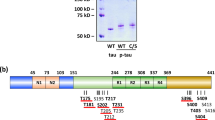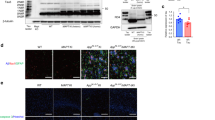Abstract
Intraneuronal deposition of filamentous tau is a hallmark of Alzheimer’s disease (AD) and related tauopathies. We developed previously a cellular model recapitulating such tau anomaly and demonstrated therein consistent production of 70-kD tau. Importantly, the 70-kD species appears to derive from tau fragments with carboxy-terminal truncation and is larger than intact tau in size, suggesting the oligomeric nature in its assembly from tau. To generate the 70-kD tau in sufficient quantity for its characterization at the molecular level, we explored and demonstrated herein that cytosine β-D-arabinofuranoside is a useful paradigm modifier to increase production of the 70-kD tau. Such oligomeric tau was enriched thereafter by immunoprecipitation to remove tau species with intact carboxy-terminus. Two-dimensional gel electrophoresis revealed that the 70-kD tau has an isoelectric point of 5.8–6.0. Future elucidation of key aggregates will provide valuable insights into the natural history of neurofibrillary degeneration and identify novel targets to develop therapeutic interventions.









Similar content being viewed by others
Abbreviations
- araC:
-
Cytosine β-D-arabinofuranoside
- AD:
-
Alzheimer’s disease
- ANOVA:
-
One-way analysis of variance
- βME:
-
β-Mercaptoethanol
- FTDP-17:
-
Frontotemporal dementia with Parkinsonism linked to chromosome 17
- GAPDH:
-
Glyceraldehyde 3-phosphate dehydrogenase
- HMW:
-
High molecular weight
- MWCO:
-
Molecular weight cut off
- NFD:
-
Neurofibrillary degeneration
- SDS-PAGE:
-
Sodium dodecyl sulfate-polyacrylamide gel electrophoresis
- Tet:
-
Tetracycline
References
Lee VM-Y, Goedert M, Trojanowski JQ (2001) Neurodegenerative tauopathies. Ann Rev Neurosci 24:1121–1159
Goedert M, Spillantini MG, Serpell LC, Berriman J, Smith MJ, Jakes R, Crowther RA (2001) From genetics to pathology: tau and α-synuclein assemblies in neurodegenerative diseases. Phil Trans R Soc Lond B 356:213–227
Buee L, Bussiere T, Buee-Scherrer V, Delacourte A, Hof PR (2000) Tau protein isoforms, phosphorylation and role in neurodegenerative disorders. Brain Res Rev 33:95–130
DeTure M, Ko L, Easson C, Yen S-H (2002) Tau assembly in inducible transfectants expressing wild-type or FTDP-17 tau. Am J Pathol 161:1711–1722
Ko L, Rush T, Sahara N, Kersh JS, Easson C, DeTure M, Lin WL, Connor YD, Yen SH (2004) Assembly of filamentous tau aggregates in human neuronal cells. J Alz Dis 6:605–622
Ko L, DeTure M, Sahara N, Chihab R, Vega IE, Yen S-H (2005) Recent advances in experimental modeling of the assembly of tau filaments. Biochim Biophys Acta 1739:125–139
Tomkins CE, Edwards SN, Tolkovsky AM (1994) Apoptosis is induced in post-mitotic neurons by arabinosides and topoisomerase II inhibitors in the presence of NGF. J Cell Sci 107:1499–1507
DeTure M, Ko L, Yen S, Nacharaju P, Easson C, Lewis J, van Slegtenhorst M, Hutton M, Yen S-HC (2000) Missense tau mutations identified in FTDP-17 have a small effect on tau-microtubule interactions. Brain Res 853:5–14
Wille H, Drews G, Biernat J, Mandelkow EM, Mandelkow E (1992) Alzheimer-like paired helical filaments and antiparallel dimmers formed from microtubule-associated protein tau in vitro. J Cell Biol 118:573–584
Greenberg SG, Davies P, Schein J, Binder LI (1992) Hydrofluoric acid-treated τPHF proteins display the same biochemical properties as normal τ. J Biol Chem 267:564–569
Kosik KS, Orecchio LD, Binder LI, Trojanowski JQ, Lee VM-Y, Lee G (1988) Epitopes that span the tau molecule are shared with paired helical filaments. Neuron 1:817–825
Hutton M, Lewis J, Dickson D, Yen S-H, McGowan E (2001) Analysis of tauopathies with transgenic mice. Trends Mol Med 7:467–470
Friedhoff P, von Bergen M, Mandelkow E-M, Davies P, Mandelkow E (1999) A nucleated assembly mechanism of Alzheimer paired helical filaments. Proc Natl Acad USA 95:15712–15717
King ME, Ahuja V, Binder LI, Kuret J (1999) Ligand-dependent tau filament formation: implications for Alzheimer’s disease progression. Biochemistry 38:14851–14859
Yen S-H, Hutton M, DeTure M, Ko L, Nacharaju P (1999) Fibrillogenesis of tau: insights from tau missense mutations in FDTP-17. Brain Pathol 9:695–705
Khlistunova I, Biernat J, Wang Y, Pickhardt M, van Bergen M, Gazova Z, Mandelkow E, Mandelkow E-M (2006) Inducible expression of tau repeat domain in cells models of tauopathy. Aggregation is toxic to cells but can be reversed by inhibitor drugs. J Biol Chem 281:1205–1214
Zhu K, Zhao J, Lubman DM, Miller FR, Barder TJ (2005) Protein pI shifts due to posttranslational modifications in the separation and characterization of proteins. Anal Chem 77:2745–2755
Acknowledgment
We thank Ms. T. Rush and S. Edwards for their technical assistance. The study is supported by the Mayo Foundation, the Smith Fellowship (J. G. K.) and grants from the National Institutes of Health (AG17216 and NS048052).
Author information
Authors and Affiliations
Corresponding author
Additional information
Special issue dedicated to John P. Blass.
Rights and permissions
About this article
Cite this article
Ko, Lw., Kulathingal, J.G. & Yen, SH.C. Cytosine β-D-arabinofuranoside used as a Paradigm Modifier to Increase Production of Tau Aggregates in a Cellular Model of Tauopathy. Neurochem Res 32, 823–832 (2007). https://doi.org/10.1007/s11064-006-9218-4
Received:
Accepted:
Published:
Issue Date:
DOI: https://doi.org/10.1007/s11064-006-9218-4




